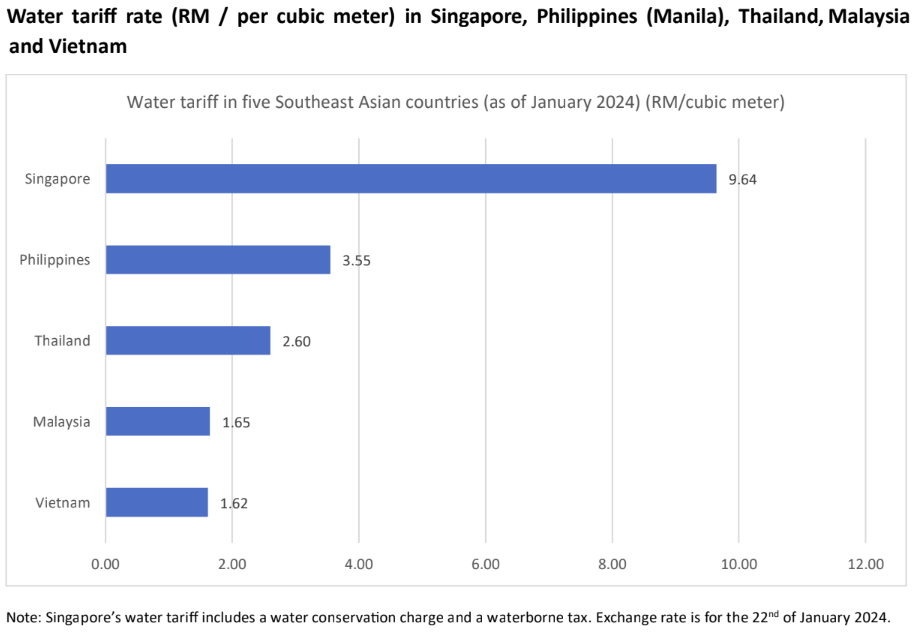
A media statement by Dr Ong Kian Ming, a former Member of Parliament for Bangi and former deputy international trade and industry minister, issued on Jan 22, 2024:
The announcement on Jan 17 by the Water Services Commission of Malaysia (Span) that the water tariff in Peninsular Malaysia and Labuan would increase by an average of 22 sen from RM1.43 per cubic metre to RM1.65 per cubic metre is a step in the right direction in improving the regulatory structure of water supply in the country, and to ensure the continued financial sustainability of the water service sector in Malaysia.
This tariff rate is still lower than the estimated RM1.75 per cubic metre it costs to supply treated water, on average.
The reality is that even after the upwards revision of the water tariff, Malaysia enjoys one of the lowest water tariffs in Southeast Asia, with only the Vietnamese tariff slightly than Malaysia (RM1.62/m3), followed by Thailand (RM2.60/m3), the Philippines (RM3.55/m3) and Singapore (RM9.64/m3).
Many of these countries have increased their water tariffs in the past few years, and will increase them in the near future.
At the same time, the federal and state governments can play their part to cushion the impact of the water tariff hike by providing targeted assistance to poorer households. For example, the Selangor government recently announced that it will absorb and bear the water tariff hike for over one million residents, covering almost 300,000 accounts that are recipients of the Datul Ehsan Water Scheme (Sade) that is aimed at the bottom 40% income group. This initiative will cost the Selangor government an addition RM6.5 million annually, with expenditure rising from RM31.8 million to RM37.3 million.
At the same time, the federal government recently announced an increase in the assistance to households that are in the hardcore poor category through the Sumbangan Asas Rahmah (Sara) programme, where the assistance has been increased from RM600 in 2023 to RM1,200 in 2024. The number of households assisted will increase from 210,000 to 700,000, with an increase in the budget allocation from RM130 million in 2023 to RM700 million in 2024.
The water tariff hike is part of the tariff setting mechanism that will allow Span to revise the water tariff every three years. But more needs to be done to restructure the water industry in Malaysia. These include:
- Putting in incentives for state water authorities to reduce non-revenue water as part of the conditions which have to be met to increase the water tariff.
- Setting up a fair and transparent system for capital expenditure (capex) spending for new residential, commercial and industrial development. Right now, there is a first-mover “disadvantage” where private developers of new property projects have to pay the upfront cost of connecting new pipes to existing ones. A better process would be for the state water authorities to come up with a better capex pricing model whereby private developers will be charged development and connection costs, whereas the capex should be born by the water authorities. This would be an improvement in the current integrated water supply scheme practised in the Klang Valley.
- Providing incentives for developers, institutions and even individuals to install infrastructure to save water consumption, and to conserve water such as rainwater harvesting.
- Coming up with creative strategies and regulations to tap into new sources of water supply, such as drawing on rivers and underground water sources for industrial water supply, which has a lower processing cost.
- Accessing new sources of financing from foreign investors and international funding organisations such as the Asian Development Bank, the European Investment Bank, the Asian Infrastructure Investment Bank, the World Bank and government-linked companies based in Singapore, for example, to increase water processing capacity, especially in the poorer states like Sabah and Kelantan, for example.
With these additional initiatives, the rules and regulations with regard to the supply of water and the financially sustainability of the water agencies which supply the water will be improved significantly!

